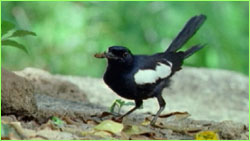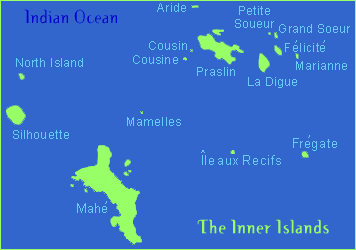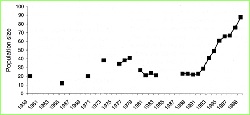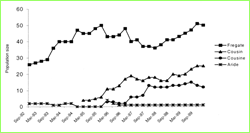 |
 |
|  A Seychelles magpie robin enjoying a
meal.
A Seychelles magpie robin enjoying a
meal.
|
Saving the Magpie Robin
by Nirmal Shah
In the late 1960s, while the world preoccupied itself with rock-'n'-roll and
flower power and moon landings, a small bird far out in the Indian Ocean came
within a hair's breadth of vanishing forever. The Seychelles magpie robin
(Copsychus sechellarum), a black-feathered bird about the size of a
European blackbird, dwindled to fewer than 20 individuals on a single island in
the Seychelles, an archipelago of about 100 granite and coral islands strewn
like a handful of beads between India and Madagascar. One bad storm, one
virulent disease could have relegated the species to the extinction
bin.
In 1990, BirdLife International launched an eleventh-hour preservation effort,
and now, a decade hence, the Seychelles magpie robin numbers 90 individuals,
with healthy populations on three islands. We at BirdLife Seychelles are proud
of the part we played in coaxing the species back from the brink, but we're
fully aware of how much we still have to do, and our motto remains "Safe But
Not Yet Secure."
The story behind this ongoing rescue is charged with frustration and
elation, grave losses and stunning victories. It's astonishing how protective
you can become of individual birds when only a handful remain, how emotional
you can feel about their well-being. We've suffered and celebrated and above
all learned a great deal over the years, and we hope that our story can offer
useful lessons for conservationists peering over similar cliff edges.
 The inner islands of the Seychelles
The inner islands of the Seychelles
|
|
Neither magpie nor robin
The Seychelles magpie robin is no bird of paradise. It cannot boast gloriously
sweeping tail feathers or a fancy plume or outrageous colors. But its dress is
as sharp as that of any bird, the males and females both bearing immaculate, glossy,
coal-black plumage with a brilliant dash of white across the wings. Before the
arrival of humans 230 years ago, the Seychelles magpie robin lived in lowland
forests hunting insects and lizards and associating with giant tortoises, which
uncovered the bird's favorite prey as they lumbered through the woods. For the
robins it was a small step from following the tortoises to following people.
Early English colonists bestowed the name magpie robin, because the bird's bold
plumage resembles that of the European magpie, and its close relationship with
humans is reminiscent of European robins.
The bird evinces a cool confidence, curiosity, and lack of fear. When you walk
in the forest, the robins seek you out, and even in your house these wild birds
will join you, bounding across the dinner table to look for scraps or loiter in
the hope of being fed. To the Seychellois, as the people of our country are
known, the Seychelles magpie robin is as precious as, say, the bald eagle is to
Americans.
While charming to us, the magpie robin's tame behavior almost led to its
downfall. Once widespread in the Seychelles, it lived in closed-canopy forest,
and its only predators were the native Wright's skink and an endemic snake,
which stole eggs and chicks from the birds' nests. But the natural balance was
thrown off in the decades after Europeans began permanently settling the
archipelago in 1770. Colonists felled the forest for timber and farmland, and
as the species became rare, bird collectors hunted it. In the
19th-century, one Frenchman reportedly shot 24 Seychelles magpie
robins in one day on the island of Aride. (If he had done that on the island of
Frégate in the 1960s, he would have extinguished the species.) Most
devastating of all were the predators that came with the settlers: rats, cats,
and the Indian mynah bird. The naïve and confiding magpie robins have no
defense against these crafty hunters, and they succumbed on one island after
the other.
|  The Wright's skink, a lizard
native to the Seychelles, likes to dine on magpie robins' eggs and
chicks.
The Wright's skink, a lizard
native to the Seychelles, likes to dine on magpie robins' eggs and
chicks.
|
By 1970, 16 Seychelles magpie robins remained on Earth, all on Frégate.
The species had become the most critically endangered of the Seychelles' 11
endemic bird species and one of the world's rarest birds. In the 1970s,
conservationists tried to start a new colony on Aride but failed for unknown
reasons. Research work took place in that decade and the one following, but no
comprehensive conservation effort existed. By 1980, the population had
increased to 27, but ten years later, it had dropped to 23. The future did not
look promising for Copsychus sechellarum.
Then, in 1990, with funding from the Royal Society for the Protection of Birds,
BirdLife International initiated its Recovery Program. Over the next decade,
the population blossomed by nearly 400 percent.
How did this happen? How does one go about saving a species so close to
extinction?
To the rescue
First, the ornithologists on the project had to ask two questions: Why is the
Seychelles magpie robin headed for extinction? And how can this slide be
reversed? To learn the chief causes of high mortality, researchers typically
rely on an experimental approach. That is, they use portions of the population
as a control to separately test each factor—for instance, habitat loss or
mynah predation—and then tease out the key limiting factors. But during such
tests, controls continue to fare poorly, and we couldn't risk that with such a
tiny population. So we studied their ecology observationally.

 The
overall population of Seychelles magpie robins has increased manifold since the
early 1990s (top chart). But a closer look at individual island populations
during the 1990s shows a species far from thriving (bottom
chart). Note: click on charts to see larger versions.
The
overall population of Seychelles magpie robins has increased manifold since the
early 1990s (top chart). But a closer look at individual island populations
during the 1990s shows a species far from thriving (bottom
chart). Note: click on charts to see larger versions.
|
|
We determined that changes in land use cause loss of
habitat, that safe nest sites were in short supply, and that Indian mynahs were
eating eggs and chicks. Surprisingly, adult birds were also succumbing to
household pesticides, which residents put out to keep down the cockroach
population. (Seychelles magpie robins love cockroaches and will eat them dead
or alive.) Perhaps the poor birds could survive one of these assaults, but not
the combined effect.
With these data in hand, Recovery Program staff got
to work. They built nest boxes and provided supplementary food every day. To
begin restoring the habitat, they replanted native trees. They banned household
pesticides and set about controlling the mynah population. Finally, they raised
public awareness by telling Frégate residents of the dangers and
distributing informational leaflets. By 1995, the Seychelles magpie robin
population had more than doubled.
Continue: Other Islands
Seychelles Through Time |
Saving the Magpie Robin
Why Do Islands Breed Giants? |
Build an Island
Resources |
Transcript |
Site Map |
Garden of Eden Home
Editor's Picks |
Previous Sites |
Join Us/E-mail |
TV/Web Schedule
About NOVA |
Teachers |
Site Map |
Shop |
Jobs |
Search |
To print
PBS Online |
NOVA Online |
WGBH
© | Updated November 2000
|
|
|